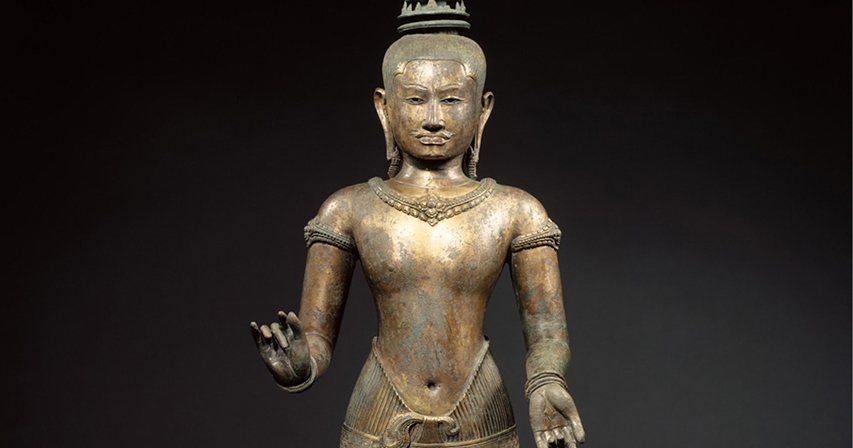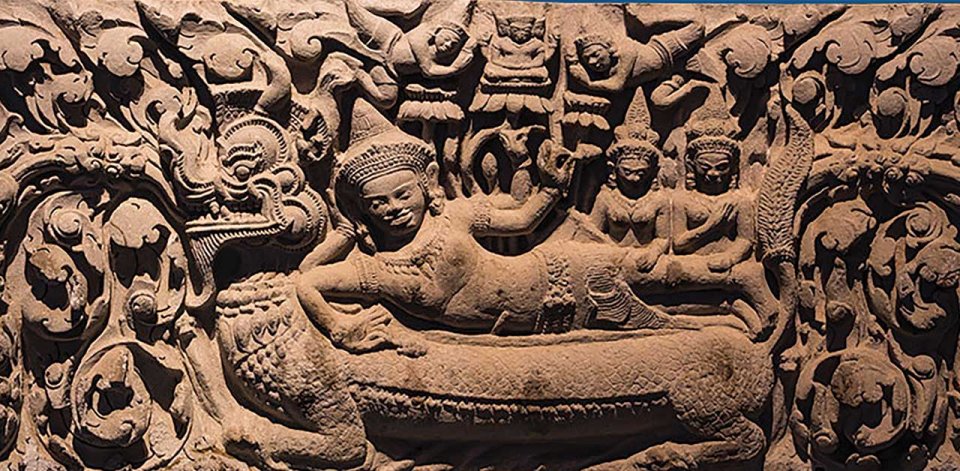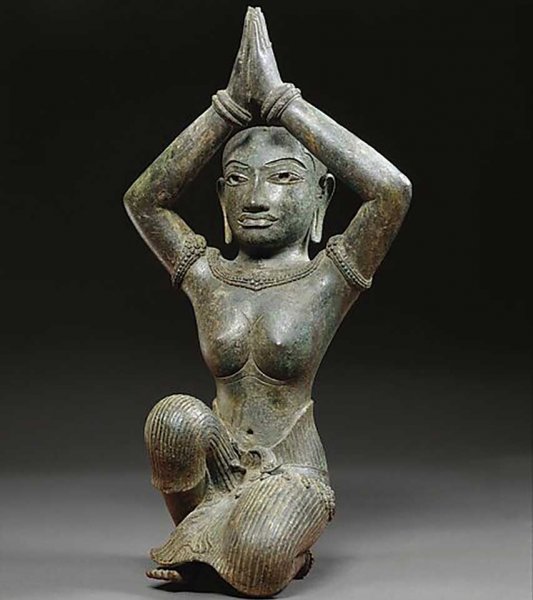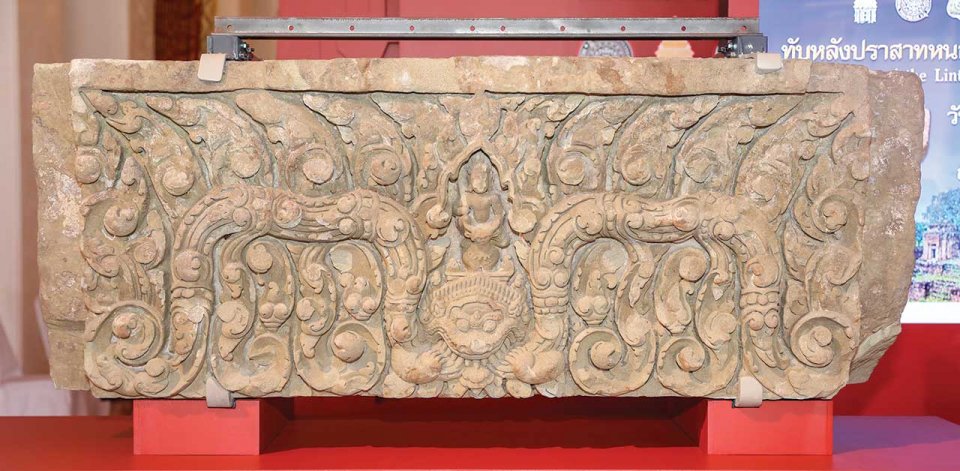“Not a lot of Thai people know that we have so many key artifacts stolen from us by foreigners,” says a representative of Sam Nuk Sam Roi Ong (SSO), wishing to be known as Khunchot. SSO means “reminiscing the 300 divinities,” an online activism group trying to raise awareness of artifacts from Thailand’s history that have been lost and looted. “What we’re trying to get repatriated doesn’t even make up 1% of the artifacts we lost, but right now we’re focusing on key pieces.”
The return of artifacts, however, is a complicated process and one that means a lot to Bangkok’s museums. The complex negotiations involving the repatriation of the statue include Thailand’s Fine Arts Department, the Royal Thai Consulate-General in New York, and National Museum Bangkok. Activists and academics in Thailand are trying to make it happen.
Using social media as a weapon, the collaboration between academics, activists, and archeologists made SSO a powerful tool in the efforts to return Thailand’s historic artifacts. The vital organization is working with institutions like US Homeland Security to fill out paperwork, raise awareness, and cooperate with the domestic authorities.
Due in no small part to the efforts of Bangkok museums, the SSO, and international cooperation, among Latchford’s artifacts, 32 items are to be returned to Thailand, according to a representative with SSO, including 18 Buddhas from Prakhon Chai.
“After we put some media pressure, eventually during Prayut’s regime, they finally formed the repatriation committee of stolen artifacts,” says Khunchot, adding that for the last 10 years America has focused on cracking down illegal international trade of artifacts which is used for money laundering and tax evasion.
“[These statues] showcase the meticulous and anatomically accurate craftsmanship of that era. It’s really amazing that people 3,000 years ago were able to create something like this with the limited technology they have,” says Khunchot. “Every statue is one of a kind and created using the lost wax casting technique. After it has been set, they will break the mold to take the finished product out. So you won’t get the exact statue again.”
The SSO group was created over 7 years ago, and Khunchot says they found they were obstructed by people who stood to profit in the trade and replica businesses.
“Before we had the official repatriation committee, we used the method of campaigning such as the case of Narai Banthomsin lintel, buying it back such as the case of the Naga Prok Statue,” says Thanongsak Hanwong, a member of the repatriation committee for stolen artifacts and an independent academic specializing in archaeology. “Three years after the establishment of the committee, we successfully brought back Nonghong and Kao Lon lintels from America.
"Anywhere there’s something valuable, there will be thievery. These artifacts are valuable and there are buyers that see this, there are merchants, there are international markets.”
Dumrong Leenanuruksa
The excuse often given for the smuggling and sale of Thai and Cambodian artifacts has been one of political instability—from the Vietnam War and coups to the Khmer Rouge. It’s a similar tale from the Elgin Marbles to Egypt. But Hanwong says this is not necessarily the case.
“I think it’s not an entirely reliable narrative. It’s true that a lot of the artifacts were stolen during the Cold War but it’s actually a misconception that these artifacts are transported via war helicopters, especially with the cases of lintels,” he says. “It’s mostly dug up by villagers and sold through foreigners that set up an agency in town. It’s quite rare for foreign soldiers to be involved.”
It has been alleged that River City in Bangkok was once a hotbed of smuggling in ancient artifacts, with claims that the shops would keep replicas on the shelves and proper works in the back for sales to hi-so customers and fences.
The Market and Protections
Disputed kneeling female figure, found at the Metropolitan Museum in New York / Metropolitan Museum
“Anywhere there’s something valuable, there will be thievery. These artifacts are valuable and there are buyers that see this, there are merchants, there are international markets,” says Dumrong Leenanuruksa, another member of the government committee to repatriate stolen artifacts and a member of SSO, formerly a teacher of agricultural studies. “Buying and selling artifacts is a gray market. People might sell the genuine ones and the replicas. It’s difficult to say how these artifacts were stolen because each decade there’s a different perpetrator, and they’ll use different methods of doing business.”
Leenanuruksa’s background is in agricultural studies at Maejo University, but after researching for more than a decade on the subject of ancient artifacts, he became involved in the SSO group.
Legally, national treasures should not be taken out of the country or sold unless approved by the Fine Arts Department, but the artifacts that find themselves in museums and private collections have sales histories that go back decades.
“Those days, the law was in practice, but the looting happened far away. There weren’t a lot of officials looking over these artifacts. The merchants would purchase it in Thai currency and resell it for many times its price in a stronger currency,” Leenanuruksa says.
It’s no coincidence that Latchford’s home was in Bangkok. Thailand is a transit country for stolen artifacts. The 1970 Unesco Convention on the Means of Prohibiting and Preventing the Illicit Import, Export and Transfer of Ownership of Cultural Property prevents the trafficking of cultural articles, but until 2000, Thai legislation imposed sanctions only on the export of artifacts originating in Thailand.
Welcome Back
Nong Hong lintel / Wikimedia
The US has been a feature of some of Thailand’s most high-profile antiquities returns, even before the crackdown on money laundering. One of the most contentious was the return of the Phra Narai Bantomsin lintel. The stone edifice went missing in the 1960s and cropped up again in the Art Institute of Chicago in the 1970s.
The lintel became a cultural touchstone, kicking off more than 18 years of controversy until the piece was returned to Thailand. Famously, the band Carabao, a Thai rock band, launched their Narai Bantomsin album with the Statue of Liberty holding the lintel—along with a track taking a swipe at Michael Jackson.
It took 18 more years before the ancient lintel was returned in exchange for B50 million in artifacts, receiving a rock star welcome at Don Mueang airport.
Similar nationalistic and historic fervor surrounded the return of the Lopburi Buddha to Thailand in 1996 from Sotheby's in London and then the US. Then there was the 2008 return of the Dvaravati Buddha statue that found its way into a private collection in New York but was discovered by Interpol.
Groups like SSO work together to repatriate Thailand’s lost artifacts, but Thailand lacks the legislative framework of its neighbor. Historically, Thailand has been much less successful than Cambodia in the return of sold and stolen artifacts. In fact, the return of the Golden Boy was predicated on Cambodia’s efforts.
“The reason why we were able to get it back is because the Cambodian repatriation team collaborated with the US,” Leenanuruksa says. Fourteen pieces were from Cambodia, and two showed origins from Thailand. “We can’t use Golden Boy as an example of Thailand repatriation because we just happened to gain it back.”
Hanwong points out that the repatriation is different for Thailand and Cambodia, stating that the Thai government uses ambassadorial connections, and the repatriation committee works through the Ministry of Foreign Affairs with America to start building a case.
Cambodia, he says, has a smaller representative group that uses direct legal contact with America sans the embassy, leading to faster and more successful results.
“In Europe, there aren’t a lot of laws in place that help with repatriation,” Leenanuruksa says. The EU has had legislation for the return of cultural objects unlawfully removed from EU countries, and the SSO has had far less cooperation from them.
History at Home

Photo: The "Golden Boy" statue due to be returned to Thailand this month / Metropolitan Museum
Thailand, too, has been the subject of repatriation efforts—largely to Cambodia. Latchford’s condo in Bangkok was filled with treasures, and on the occasion of his death, 25 works, some dating back more than 1,000 years, made their way from Sukhumvit to Cambodia. Similarly, Thailand returned 12th century statues confiscated from smugglers in 2009 after a decade. In fact, Cambodian archeologists have expressed disappointment that the Golden Boy would be going to Thailand, casting doubt on its original provenance rather than the discovery site.
National Museum Bangkok is currently in the process of preparing for the return of the Golden Boy. The official repatriation ceremony will be held in May and the statue will be on display after the celebration.
Thailand’s repatriation committee has submitted documents requesting the return of over 30 artifacts to various countries, but there’s no telling how many will return—either from the Latchford holdings or elsewhere.
“History is the most important thing to understand and develop a good international relationship,” Hanwong says. “For example, the artifacts we’re trying to claim back will explain Thai and Cambodian historical relations. It shows that we have the same cultural and societal roots, from the past to present day.”



